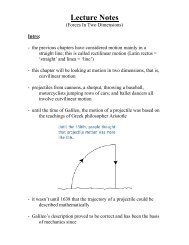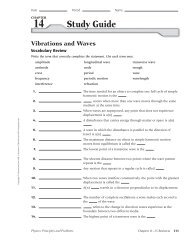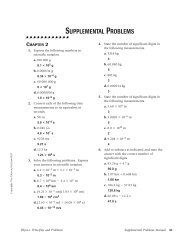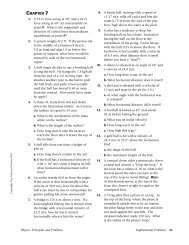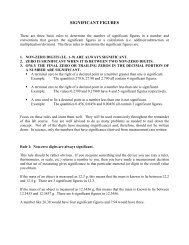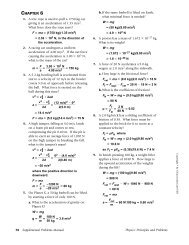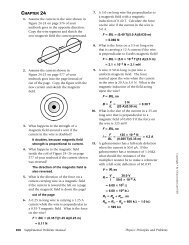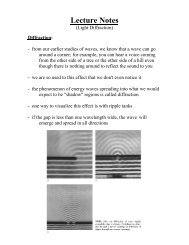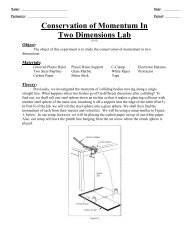Lecture Notes (Impulse & Momentum) - Dickey Physics
Lecture Notes (Impulse & Momentum) - Dickey Physics
Lecture Notes (Impulse & Momentum) - Dickey Physics
Create successful ePaper yourself
Turn your PDF publications into a flip-book with our unique Google optimized e-Paper software.
- a long sustained force will produce a greater change inmomentum than the same force applied briefly- in terms of momentum, both the amount of force and the amountof time during which the force act are important; the productof these two terms is called the impulse<strong>Impulse</strong> = force × time interval<strong>Impulse</strong> = FΔt- whenever you exert a force on an object you also exert animpulse- the resulting acceleration depends on the force; the resultingchange in momentum depends on the force and the time inwhich the force acts<strong>Impulse</strong>-<strong>Momentum</strong> Equation:- the relationship of impulse and momentum is derived fromNewton's 2nd law of motion; F = ma; then time interval ofimpulse is hidden in the acceleration variable (Δv/Δt)- if you rearrange Newton's 2nd law you get:Force × time interval = change in mass × velocity (momentum)FΔt = mΔv
- the force that is exerted on most objects varies over time; forexample, in the cannon the gunpowder applies a greater forceinitially and the begins to lessen as the shell goes down thebarrel- so, in order to simplify things, we will use the average forceacting on an objectDecreasing <strong>Momentum</strong> (Over a Long Time):- one intuitive way to discuss decreasing momentum is to imagineyou are in a car out of control and you can either slam into aconcrete wall or a haystack- it's obvious which solution is the better choice; the moreimportant reason in physics is why this is the better choice- in either case, hitting the wall or the haystack, your momentumwill be decreased by the same impulse (FΔt); rememberimpulse is the product of force and time, but does not meanthe same force or same time- you have a choice; if you hit the haystack your time will beextended (the time during which your momentum is broughtto zero)- this longer time corresponds to a lesser force; for example, if youextend the time by 100 times, then the force will decrease by100- if you hit the wall, the time will be reduced, so the force willincrease
- people often use the knowledge of impulse to their advantage;for example, a wrestler thrown to the floor will relax theirmuscles in order to extend the crash into a series of smallerimpacts- the wrestler will have his/her foot, knee, hip, ribs, and shoulderhit the mat in turn; this will increase the time of impact whichreduces the amount of force on the body- a boxer will move his face backwards in order to increase thetime of impact of an opponent's blow- ballet dancers prefer to dance on a wooden floor rather than aconcrete floor, because the wooden floor has "give"
Decreasing <strong>Momentum</strong> (Over a Short Time):- in certain situations it is advantageous to decreaseyour momentum quickly- when you decrease the time interval, the size ofthe force will increase; for example, a karatemaster will endeavor to hit a stack of brickswith a quick blow; this will maximize theforce of the blowBouncing:- impulses become even greater if bouncing occurs- bouncing will amplify the impulse because it takes an additionalimpulse to throw an object back after collision- for example, take the case of a flower pot hitting you head; if thepot breaks upon colliding with your head it does somedamage; if the pot bounces off your head without breaking, itwould do even more damage to your body- your head has to provide an additional impulse to send the potback off your head- the effect was known and used for mining in California duringthe gold rush; a man named Pelton created a water wheelwith curved blades to maximize the impulse of the water onthe wheel



